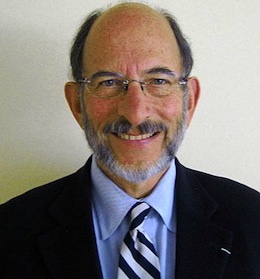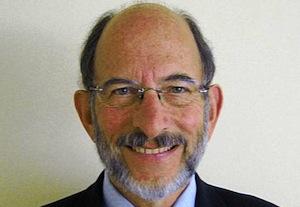
By the time Peter Pastreich reached the podium on the lower level of the Herbst Theatre last Friday night, at a postconcert reception marking his retirement as executive director of the Philharmonia Baroque Orchestra, he’d heard himself praised in many ways.
“Peter came to us out of the blue in a time of need,” said violist Ellie Nishi. “He’s always planting the seeds for the next generation of leaders,” noted General Manager Michael Costa, himself a graduate of his boss’ esteemed “Essentials of Orchestra Management” seminar in New York. Ticking off Pastreich’s contributions to Philharmonia Baroque’s touring program, its revitalized recording, and its broadcast presence on KDFC, as well as the work he did to improve the acoustics of the Herbst, Music Director Nicholas McGegan put the case directly.
“You,” he said to the outgoing administrator, “are the prince of the profession.”
It was left to the honoree himself, then, to balance the ledger. After graciously thanking everyone for their tributes, Pastreich recalled what the late San Francisco Symphony patron Agnes Albert said when he was hired as executive director of that organization in 1977. “‘Oh, he’ll be great for the orchestra,’” Albert observed, “‘if you can stand him.’”
The line drew a laugh, of course. But it also got at some important central truths about Pastreich’s style and substance as a leader. Difficult and demanding as he can be, Pastreich has left his mark by thinking and acting independently, challenging conventional wisdom, scrutinizing both himself and others, and skillfully orchestrating the multiple personalities and factors that churn behind the scenes of orchestral music-making.
“You are the prince of the profession.” – McGegan to Pastreich
Fittingly, Philharmonia board President Paul Sugarman cited one of his executive director’s choice one-liners: “‘For every problem there’s a solution that’s clear, direct, and wrong.’”
Critical Leadership in Challenging Times
In a distinguished 53-year career of seeking and often finding the sometimes counterintuitive right solutions, Pastreich ushered the San Francisco Symphony through two dramatic decades of growth and transition from the pre–Davies Symphony Hall late 1970s to the flourishing Michael Tilson Thomas era of the 1990s; steered Philharmonia Baroque for two and a half eventful years; and engineered the move to a new hall as executive director of the St. Louis Symphony, after stints with the Nashville Symphony, Denver Symphony, Baltimore Symphony, and others. For 10 years following his resignation from the San Francisco Symphony in 1999, Pastreich consulted to major orchestras, including the Berlin Philharmonic, in Europe and the U.S.
“What Jewish boy from Brooklyn wouldn’t want to tell the Berlin Philharmonic what to do?” asked a straight-faced Pastreich, 73, in the midst of an amiable and forthcoming conversation at his sun-filled Civic Center office a few days before his farewell fete. His retirement is effective at the end of the year.
With two of Philharmonia Baroque’s CDs making the New York Times best-of-the-year list (a Grammy nomination for the orchestra’s recording of three Haydn symphonies would come the next day), Pastreich mused on an activity that changed profoundly during his years in the business.
“For every problem there’s a solution that’s clear, direct, and wrong.” – Pastreich
“When I began, the joke was that the most famous orchestras in America were St. Martin in the Fields and the Boston Pops. The only orchestras that recorded were the New York Philharmonic, the Philadelphia Orchestra, the Chicago Symphony Orchestra — and the Boston and Cleveland orchestras, some,” said Pastreich. “Most of it was done for prestige, with the big labels subsidizing it from their pop artists. Classical was a drop in the bucket compared to the Beatles or Frank Sinatra.” Some of those subsidies were substantial. At one point the New York Phil took in $1 million a year — 10 percent of its budget — from its recording contract.
But as the big labels were bought up or foundered and as smaller orchestras wanted to get into the act — recording added prestige for touring — the ground began to shift, and then shift some more. Pastreich helped negotiate a new deal that freed orchestras like his own St. Louis Symphony from prohibitive national pay scales for the musicians. Today, with the CD a semiendangered species in the age of digital downloads, Pastreich remarked, “It’s a totally different world.”
Yet it’s not one that’s shaken his faith. Witness his campaign to get Philharmonia Baroque recording again, after a long hiatus, on its own label. The survival of recorded music, for Pastreich, holds a deeper message about the art form itself.
“I don’t see a lack of interest in classical music,” he said. “It’s as important as it was 50 or 100 years ago. There are many people whose lives would be meaningless without it.”
Same Crises, Different Remedies Needed
Asked if he was leaving the music business at a time when it’s in crisis, with audiences aging and declining and orchestras in Detroit, Philadelphia, and elsewhere in deep financial trouble, Pastreich replied, “I can hardly remember a time when it wasn’t in crisis.” In the 1970s, he recalled, a widely circulated report said that orchestras would be out of business in 10 years. The contention was that they couldn’t solve their problem by building their endowments.
“It was quite convincing.” said Pastreich, “except that it was totally wrong.” Many orchestras did precisely what the research said they couldn’t — they weathered the storm and built for the future by beefing up their endowments. One of his wish lists for Philharmonia Baroque is to grow its current $1.4 million endowment to $10 million.
Pastreich noted that both Leonard Bernstein and Ernest Fleischmann, the longtime executive director of the Los Angeles Philharmonic, gave speeches predicting the death of symphony orchestras. Another widely read paper in the ’90s argued that the gap between income and expenses would finish them off.
“The misconception is that orchestras exist because rich people give them money and a large number of people will buy tickets at whatever the price,” said Pastreich. “The reason orchestras exist is because musicians want to play music together. They’ll do it for $10 dollars a week or $10,000.”
Pastreich said he wished Philharmonia Baroque players made $100,000 a year instead of $16,000. “But I’m not sure they would play much better. They’re going to play music no matter what. That’s what they do. The San Francisco Conservatory of Music has more applicants than ever before. I keep seeing these incredible young musicians at 10 years old who are passionate to make music. I don’t see that changing.”
Pastreich ushered the San Francisco Symphony through two dramatic decades of growth and transition.
Pastreich, as much as anyone, knows that drive and willpower have to operate in the real world. He acknowledges that current conditions are tough. This recession, he said, is “really serious,” eroding both box office and contributed income. And then there’s competition — not so much from other performing arts groups as from the lure of staying home with Netflix.
Determined to write a long-delayed book about orchestras and orchestra management, now that he’s “really retiring,” Pastreich is a fount of intriguing insights. Describing the job of executive director as an orchestra’s “closet CEO,” he discussed the complicated dynamic of hiring the right music director for the right orchestra and the right reasons. Tilson Thomas, he pointed out, had been passed over by other orchestras and was “not a big name when he came to San Francisco. But it was exactly the right chemistry here.” Georg Solti, by contrast, was “the perfect match for Chicago’s power-playing tradition but probably wouldn’t have worked here. He refused to go to parties. [Carlo Maria] Giulini was a great artist, but he was all wrong for L.A. Gustavo Dudamel is L.A.”
Pastreich cautioned against hiring music directors who are too good at raising money: “It makes it very hard for the board to fire them.” He noted that while executive directors don’t hire music directors (boards do), they do play a big role in inviting guest conductors, a more important duty than it might seem. “If you want to know who’s going to succeed MTT someday, look at the list of frequent guest conductors. The name is in there somewhere.”
Quieter Years on the Horizon
Pastreich is looking forward to spending more time with his five children — one of whom, Michael Pastreich, is president and CEO of the Florida Orchestra — and five grandchildren. He already spends plenty of quality time with Oscar, an ebullient 4-year-old Havanese dog who rested close to his master’s feet when he wasn’t dashing around the Philharmonia Baroque offices.
With homes in Sausalito and the south of France, Pastreich may not be as much of a fixture at Herbst, Davies Hall, and other local venues as he has been over the years. Still, he isn’t about to give up live music after attending thousands of concerts. One of the high points of his Philharmonia Baroque terms, he reflected, was hearing the orchestra play Haydn’s Symphony No. 104 for the first time.
“I absolutely love Haydn,” said Pastreich. “I tried to get MTT to do a whole season where he would program a Haydn at every concert. He didn’t go for it. Anyway,” he went on, “when I heard Nick [McGegan] conduct that symphony, it was such a different sound and approach, like what Haydn must have intended. It was a complete revelation. I started to cry.”
After more than a half century of making music happen, Peter Pastreich is still learning how to listen.

